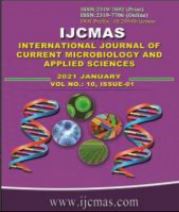


 National Academy of Agricultural Sciences (NAAS)
National Academy of Agricultural Sciences (NAAS)

|
PRINT ISSN : 2319-7692
Online ISSN : 2319-7706 Issues : 12 per year Publisher : Excellent Publishers Email : editorijcmas@gmail.com / submit@ijcmas.com Editor-in-chief: Dr.M.Prakash Index Copernicus ICV 2018: 95.39 NAAS RATING 2020: 5.38 |
The present experiment was conducted to study the effects of different land use classes on some selected physico-chemical properties of soil. Surface (0-20 cm) and Sub-surface (20-40cm) soil samples were collected from forest, agriculture and horticulture soils. The processed soil samples were used for laboratory studies i.e. texture, pH, EC, organic carbon, calcium carbonate and cation exchange capacity. The soils of District Ganderbal under different land use systems showed textural variation i.e., silt loam to silty clay loam in forest and horticulture soils while it showed silty clay loam to clay loam in agricultural soils.The forest, agricultural and horticulture land uses showed a pH of 6.7, 7.34 and 7.14 and 6.9, 7.34 and 7.34 in surface and sub-surface soils respectively. The EC of surface soils and sub-surface soils ranged between 0.16, 0.23 and 0.21dSm-1 and 0.23, 0.25 and 0.24 dSm-1 in forest, agricultural and horticultural soils respectively. The organic carbon content in surface soils and sub-surface varied from 1.80, 1.09 and 1.10 and 1.5, 0.67, 1.00 per cent in forest, agricultural and horticultural soils respectively. The calcium carbonate content in surface soils and sub-surface soils varied from 0.15, 0.57 and 0.61 and 0.19, 0.67 and 0.66 per cent in forest, agricultural and Horticultural soils respectively. The cation exchange capacity under selected land uses varied from 15.48, 15.64 and 15.11C molckg-1 and in sub-surface soils from 15.99, 16.33 and 16.15C molc kg-1 in forest, agriculture and horticulture respectively.
 |
 |
 |
 |
 |